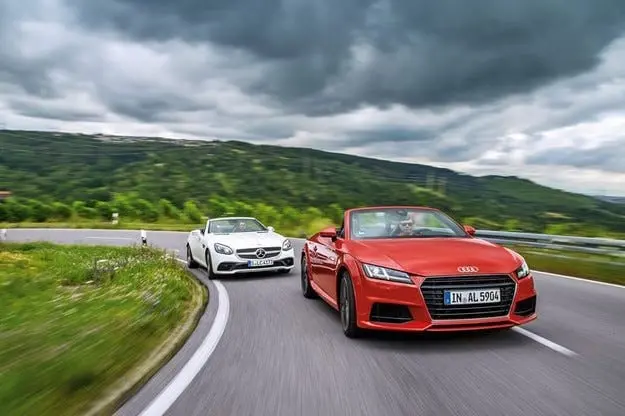
Test drive Audi TT 2.0 TFSI against Mercedes SLC 300: duel of roadsters
Content

The last episode of the rivalry between two elite open models
A convertible cannot change the weather outside. But it can allow us to relive the beautiful hours more intensely so that our dreams come true. After its update, the Mercedes SLK is now called the SLC and today it meets at an open-air party. Audi TT.
SLC, SLC. C, not K - what's so difficult here? However, when updating Mercedes models, we are rather slowly getting used to the changed nomenclature. Along with the new name, the front end has changed, but all the good things are the same: a metal folding roof, suitability for all weather conditions and comfort for every day. New in the automotive and sports world is the 300 hp 245 open two-seater drive. Yes, it was available towards the end of the SLK's production run, but we haven't seen it in a test car yet. The four-cylinder engine is very powerful. In this regard, a good company makes this 2.0 TFSI from the Audi TT (230 hp), which, in combination with its dual-clutch gearbox, noticeably attracts attention - with a piercing crack when changing gears.
Sports muffler creates a phantom feeling of more cylinders
From a technical point of view, this sound effect is as unnecessary as the SLC 300's booming bass. However, they alleviate the sadness associated with downsizing and neutralize the fear of castration of the car - all thanks to the standard sports muffler. This keeps the XNUMX-litre turbo engine from sounding dull, but boosts deep frequencies, creating an acoustic mirage for more cylinders. Some listeners imagine one, others two, and in some cases even four additional cylinders - depending on the load and the selected driving mode.
This psychoacoustic trick is more harmless than a loud TT switch. Many people like the crackle of a chaotic ignition when changing gears in a loaded mode; others see him as too arrogant and definitely too strong. On the other hand, the fast and safe gear shifting makes a positive impression, making you forget that this Audi can only distribute torque to six gears. The slight twitching at a sudden start is not well perceived.
Mercedes' merits are preserved in the SLC
The SLC also sometimes feels twitching - this happens when switching in the city, which is somehow unmotivated. The Mercedes Roadster can choose between nine gears with a wide ratio range. On the highway, this significantly reduces engine speed, which enhances the feeling of a calm and confident ride. Unfortunately, the torque converter transmission isn't exactly perfect here either. If you want to use all the power, this forces the gearbox to shift down a few steps, after which it starts shifting gears for a long time and on circumstances. Combined with slightly higher fuel consumption, this is the reason Mercedes lost, albeit by a hair's breadth, on the powertrain side. When you step onto an empty road winding through nature, your best bet is to take full control of the transmission and use the steering wheel straps to order a single shift (preferably in Sport Plus mode). The motto here is "active driving" - what really creates a good mood in this Mercedes.
So let's open the roof. The mechanism works up to 40 km / h, but unlike what is used in Audi, it has to start on the spot. When folded, the metal roof takes up part of the trunk, but when it is raised, it makes the SLC more resistant to the vagaries of time and random attacks. In addition, it better insulates passengers from the groans of the wind and, with a larger window area, provides a slightly better view, which benefits from a part of the body. When the deflector is installed (on an electric Audi) and the side windows are up, airflow can only overwhelm you, even when you are driving at 130 km / h. If you like rough surroundings, you may not order the anti-vortex barriers at all and lower the windows. On a fragrant summer evening, when the wind brings the pungent smell of fresh hay into the car, there are many less enjoyable ways to travel.
Increased comfort brings Mercedes victory in the eponymous section of the test; Thanks to the adaptive dampers, it's more willing to take on the lateral joints than the Audi model, which is also more nervous at high speeds on the highway. It remains the same at a slower pace, that is, on a normal road - that's right, again under the motto "active driving" - but there we must look for a more positive expression and call it agile. The TT almost impatiently enters the corner, remains unflappable at the peak, and when accelerating at the exit, it transfers tangible moments to the steering. It does not remain completely free from drive influence, as is the case with the SLC.
Audi TT keeps up with less power
We are witnessing an episode of the classic rivalry between the front and rear transmission, because here Audi does not participate in the Quattro version. Indeed, the front of the TT weighs next to nothing and the back of the SLC barely serves. Surprisingly, however, Mercedes' cornering pleasure zone starts at a much lower speed, probably because its tires start to complain too early and thus loudly announce that they are reaching the traction limit in a wide range of speeds. Since then, SLC has continued to steadily follow the desired course - for a long, very long time. The test machine is equipped with a dynamic package; it lowers the two-seat model's ride height by ten millimeters and includes a direct steering system as well as adjustable dampers.
Despite less power, the lighter competitor keeps the Mercedes SLC from breaking away when driving on a regular road and follows in its footsteps. The only drawback noted by the driver is that excellent handling is presented in a slightly synthetic form - the TT feels like it has been artificially tuned for more agile handling. It's faster in the lab on the test track, as well as at the Boxberg test site, but that doesn't say much about the driving experience. It's bigger in the SLC, because the Mercedes model handles analog in a positive way and with an authentic feel, which gives it a slight advantage in assessing road behavior.
Mercedes SLC loses a lot because of cost
The Audi spokesman makes no secret of the fact that he feels connected to the virtual world, and makes this the main theme of management - and in the most consistent way today. Everything is concentrated on one screen, everything can be controlled from the steering wheel. The best thing to do is to ask a friendly consultant in the showroom to explain the system to you and then practice together. This kind of preparation never hurts, but with the mostly traditional controls in the SLC, it's not absolutely necessary - in a similar world, you can learn almost everything through trial and error.
However, SLC has firmly established its place in today's world in terms of security equipment. Automatic airbag assistance signal, tires with emergency driving performance, forward collision warning and autonomous braking even at speeds above 50 km/h are just some of the additional offerings that make everyday life in real traffic more vivid. safe. It's all the more surprising that the folks at Mercedes didn't improve the performance of the brakes when redesigning the convertible; for example, at a speed of 130 km / h, the Audi roadster stops almost five meters earlier and thus returns part of the lost points.
Indeed, this is not enough to catch up with quality scores. But in the value section, the TT started off in an excellent position. Potential buyers should pay less for it, as well as for regular options - and do not forget about fuel. The higher cost has a double negative effect on Mercedes. Firstly, because it consumes an average of half a liter more per 100 kilometers, and secondly, because it requires expensive gasoline with an octane rating of 98, while 95-octane gasoline is enough for Audi. So the TT secured such a telling win in the cost section that it turned the score on its head: the SLC is indeed the best two-seat convertible, but it loses in this test because of its salty price tag.
Roadsters on a steerable track
On the handling track, which is part of the Bosch test site in Boxberg, auto motor und sport recently measured the lap times of sports models and variants. The section resembles a secondary road with a rather complex configuration, contains both sharp and wide sequential turns, as well as a smooth chicane. The best value so far is 46,4 seconds, achieved by the BMW M3 Competition. Neither of the two convertibles approaches her. Since the temperatures were different in previous measurements, only the times determined in the same test can be directly compared with each other.
Thanks to the wider front tires, the TT enters corners more spontaneously and remains largely neutral. You can step on the accelerator earlier and this will result in a lap time of 0.48,3 minutes. The SLC always remains easy to control, suppressing dynamic load response. Slight understeer slows it down compared to the TT, so it takes a full second more on the track to handle (0.49,3 min).
Text: Markus Peters
Photo: Arturo Rivas
Evaluation
1. Audi TT Roadster 2.0 TFSI – 401 points
The TT benefits from a significantly lower base price and better braking distance, but has to lose quality ratings.
2. Mercedes SLC 300 – 397 points
Comfort has always been a strong point of the SLK, but in its embodiment the SLC manages to be both dynamic and emotional. However, on the last meters (in the cost section) he stumbles and loses by a small margin.
technical details
| 1. Audi TT Roadster 2.0 TFSI | 2.Mercedes SLC 300 | |
|---|---|---|
| Working volume | 1984 cc | 1991 cc |
| Power | 230 k.s. (169 kW) at 4500 rpm | 245 k.s. (180 kW) at 5500 rpm |
| Maximum torque | 370 Nm at 1600 rpm | 370 Nm at 1300 rpm |
| Acceleration 0-100 km / h | 6,3 with | 6,3 with |
| Braking distances at a speed of 100 km / h | 34,1 m | 35,9 m |
| full speed | 250 km / h | 250 km / h |
| Average consumption fuel in the test | 9,2 l / 100 km | 9,6 l / 100 km |
| Base Price | 40 500 EUR (in Germany) | 46 380 EUR (in Germany) |

